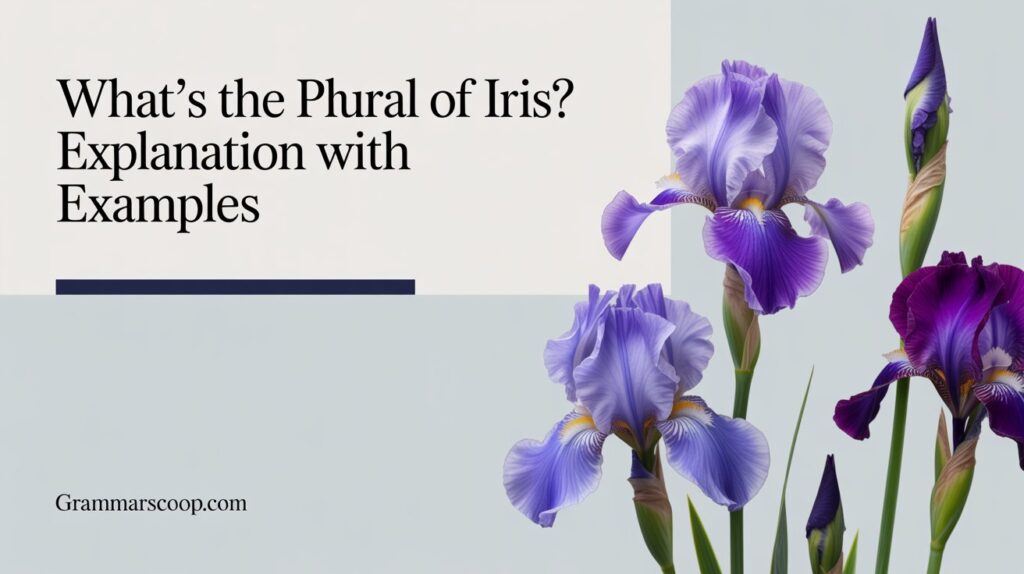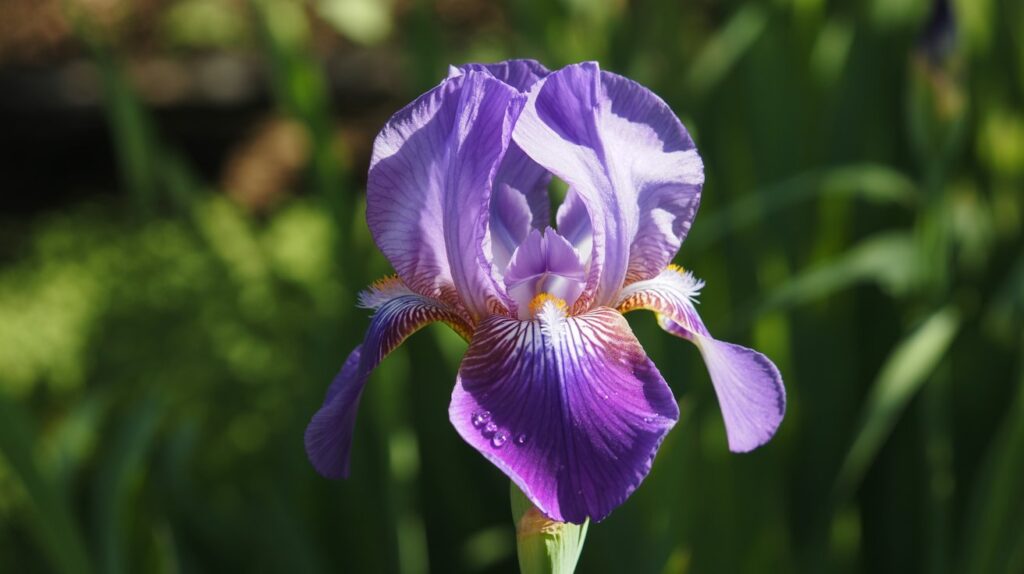Language has a way of surprising us, especially when it comes to plural forms. One of the most intriguing cases? The word “iris.” You’ve probably seen a garden full of iris flowers or read a science article about the human eye. But when more than one is involved, what’s the correct plural of iris? Is it “irises” or “irides”? Or is there another iris plural form you’ve never even considered?
Let’s unravel this linguistic puzzle with clarity, real-world examples, and guidance you can trust. By the end of this guide, you’ll know exactly which plural of iris to use and when.
Quick Answer: What Is the Plural of “Iris”?

The word “iris” has two accepted plural forms:
| Plural Form | Context | Pronunciation | Example |
|---|---|---|---|
| Irises | Common, botanical, artistic | /ˈaɪrɪsɪz/ | The garden was filled with blooming irises. |
| Irides | Scientific, medical | /ˈaɪrɪdiːz/ | The doctor examined both irides for signs of infection. |
In short:
- Use irises when talking about iris flowers or in general speech.
- Use irides in medical or scientific contexts, especially referring to the eyes.
When to Use “Irises”
The most common plural of iris you’ll come across is “irises.” It’s used widely in:
Botanical and Gardening Contexts

When referring to the popular iris flower, “irises” is the standard plural form.
Quote: “Van Gogh’s Irises painting was inspired by the vibrant blues in the monastery garden.”
You’ll find this form on:
- Seed packets
- Gardening guides
- Landscaping articles
- Floral design catalogs
Example Sentences:
- I planted a mix of purple and yellow irises this spring.
- The garden center is having a sale on all iris flowers plural varieties.
Creative and Figurative Usage
Writers, poets, and artists often use “irises” metaphorically to describe:
- Eyes
- Colors
- Emotions
Example:
Her violet irises seemed to shimmer under the moonlight.
Here, while referring to eyes, “irises” still works in creative writing because it evokes a softer, more expressive tone than “irides.”
Everyday and Informal Use
In casual conversation or non-technical writing, “irises” is the go-to. It sounds more natural and fits well in blogs, stories, and general communication.
When to Use “Irides”
If you’re dealing with anatomy or anything scientific, “irides” is the correct term.
Medical and Scientific Use
Doctors, biologists, and researchers prefer “irides” when discussing human or animal eyes.
Example:
- The ophthalmologist noticed inflammation in both irides.
Use Cases:
- Medical journals
- Clinical notes
- Biology textbooks
Latin Legacy
The word “iris” comes from the Greek “ῖρις” (iris) meaning “rainbow.” It was later adopted into Latin and kept its original form. In Latin, the plural of words ending in “-is” is often “-ides.”
That’s why terms like:
- epididymis → epididymides
- testis → testes
have similar transformations in academic writing.
Formality & Tone
Using “irides” can sound scholarly, so it fits well in academic writing or professional reports. But in casual talk? It might sound out of place.
A Short Origin Story of the Word “Iris”
| Language | Word | Meaning |
|---|---|---|
| Greek | ῖρις (iris) | Rainbow; goddess Iris (messenger of the gods) |
| Latin | iris | Colored part of the eye; flower |
| English | iris | The part of the eye AND a genus of flowers |
The word made its way into English through Latin, but because it has dual meanings (eye and flower), it kept dual plural forms as well.
Fun Fact: The name “Iris” also became popular for girls because of its link to color, beauty, and light.
Common Misuses and Mistakes
It’s easy to stumble with the plural of iris. Let’s fix that.
Don’t Use These:
- “iri” (Not a word)
- “iris’s” (Possessive, not plural)
- “iriss” (Incorrect spelling)
Watch for Verb Agreement
Wrong: The irises was blooming beautifully.
Right: The irises were blooming beautifully.
Be Consistent
If you’re writing a report, stick with one plural form throughout. Switching between “irises” and “irides” confuses readers.
Explore further:
- High-Quality Or High Quality: Which One Is Correct?
- Plural of Journey: Is It Journeys or Journies?
- Liter or Litre: Spelling Differences and When to Use Each
- Agreeance vs Agreement: Which One to Use?
- What’s the Past Tense of Panic?
Sentence Bank: How to Use “Iris” in Real Sentences
Singular Usage
- The iris of the eye controls how much light enters.
- I sketched a single iris blooming in a pot.
- Her iris changed color in the sunlight.
Using “Irises” (Flowers and Creative Contexts)
- The bouquet contained yellow tulips and purple irises.
- Irises are known for their sword-shaped leaves.
- The painter captured the iris plural beauty in bold strokes.
Using “Irides” (Medical and Scientific Contexts)
- The study observed pupil dilation across different irides.
- Both irides responded to light stimuli.
- Infection was detected in the irides of the test subjects.
Related Words with Dual Plurals
English isn’t the only language where this happens. Several borrowed words have both “regular” and “Latin” plurals:
| Singular | Regular Plural | Latin Plural |
|---|---|---|
| Antenna | Antennas | Antennae |
| Appendix | Appendixes | Appendices |
| Index | Indexes | Indices |
| Iris | Irises | Irides |
Tip: In most cases, the Latin plural is used in technical or scientific writing, while the regular plural is used in everyday language.
What Style Guides Say About the Plural of Iris
Let’s check in with major editorial authorities:
| Style Guide | Preferred Form | Notes |
|---|---|---|
| APA | Irides | Scientific writing, anatomy |
| Chicago | Irises | General usage, books, articles |
| AMA | Irides | Required for medical contexts |
| Merriam-Webster | Irises & Irides | Lists both as valid |
| Oxford English Dictionary | Irises & Irides | Both accepted with context |
Conclusion: There’s no one “right” plural of iris — context is king.
Real-World Examples
Case Study 1: A Gardening Blog
Post Title: Top 5 Irises for Spring Gardens
Usage: “These dwarf irises thrive in rocky soils and add bursts of color to any border.”
Case Study 2: Medical Research Article
Journal: Ophthalmology Today
Sentence: “Photographic imaging revealed inflammation in the irides post-surgery.”
Case Study 3: Art Critique
Publication: The Met Quarterly
Excerpt: “Van Gogh’s Irises burst with a sense of urgency and movement.”
These real-life examples reinforce how context determines which plural you should use.
Quick Infographic Overview
Here’s a breakdown you can remember (visualize this as a diagram or shareable image):
+----------------------------+
| PLURAL OF IRIS |
+----------------------------+
/ \
/ \
Botanical, Creative Scientific, Medical
"Irises" "Irides"
(flowers, eyes in art) (anatomy, clinical work)
Final Thoughts: Pick the Right Iris Plural with Confidence
To wrap things up:
- Both irises and irides are correct plurals of iris.
- Use irises for flowers, creative writing, and general topics.
- Use irides for technical writing, anatomy, and scientific contexts.
If you’re ever unsure, default to “irises” — it’s more common and widely understood.
Pro Tip: Want to sound more human and less robotic in your writing? Choose “irises.” Want to impress a room full of scientists? Use “irides.”
Whether you’re describing a bouquet, analyzing artwork, or diagnosing an eye condition, you now know exactly which iris plural form fits best.
Want a quick refresher later? Bookmark this guide or share it with a friend who’s ever wondered about the correct plural of iris flowers.

Lisa Morris is a seasoned blogger and language enthusiast with a passion for making grammar simple and engaging. At Grammar Scoop, she shares clear, concise tips that help readers master the rules of English with confidence.






